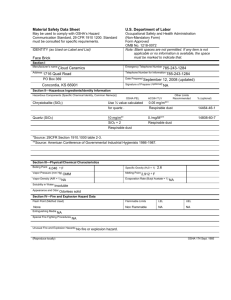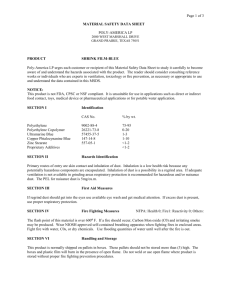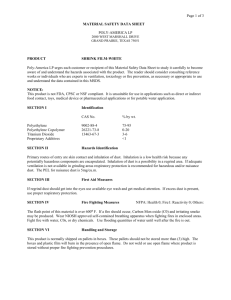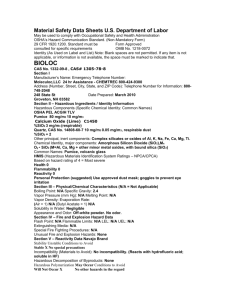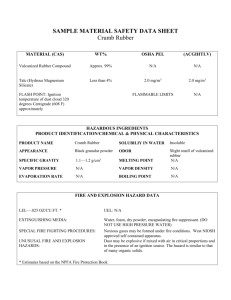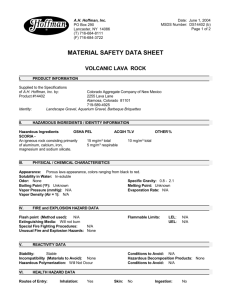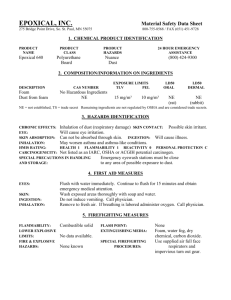Section II-A Hazardous Ingredients
advertisement
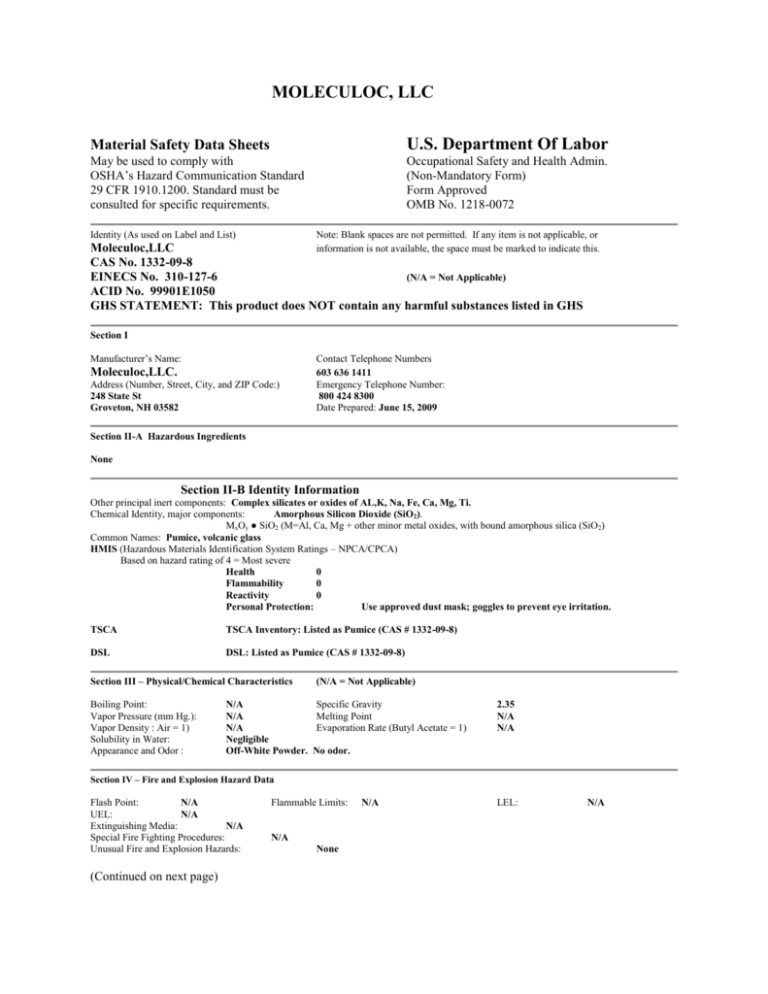
MOLECULOC, LLC Material Safety Data Sheets U.S. Department Of Labor May be used to comply with OSHA’s Hazard Communication Standard 29 CFR 1910.1200. Standard must be consulted for specific requirements. Occupational Safety and Health Admin. (Non-Mandatory Form) Form Approved OMB No. 1218-0072 Identity (As used on Label and List) Note: Blank spaces are not permitted. If any item is not applicable, or Moleculoc,LLC information is not available, the space must be marked to indicate this. CAS No. 1332-09-8 EINECS No. 310-127-6 (N/A = Not Applicable) ACID No. 99901E1050 GHS STATEMENT: This product does NOT contain any harmful substances listed in GHS Section I Manufacturer’s Name: Moleculoc,LLC. Address (Number, Street, City, and ZIP Code:) 248 State St Groveton, NH 03582 Contact Telephone Numbers 603 636 1411 Emergency Telephone Number: 800 424 8300 Date Prepared: June 15, 2009 Section II-A Hazardous Ingredients None Section II-B Identity Information Other principal inert components: Complex silicates or oxides of AL,K, Na, Fe, Ca, Mg, Ti. Chemical Identity, major components: Amorphous Silicon Dioxide (SiO2). MxOy ● SiO2 (M=Al, Ca, Mg + other minor metal oxides, with bound amorphous silica (SiO2) Common Names: Pumice, volcanic glass HMIS (Hazardous Materials Identification System Ratings – NPCA/CPCA) Based on hazard rating of 4 = Most severe Health 0 Flammability 0 Reactivity 0 Personal Protection: Use approved dust mask; goggles to prevent eye irritation. TSCA TSCA Inventory: Listed as Pumice (CAS # 1332-09-8) DSL DSL: Listed as Pumice (CAS # 1332-09-8) Section III – Physical/Chemical Characteristics (N/A = Not Applicable) Boiling Point: Vapor Pressure (mm Hg.): Vapor Density : Air = 1) Solubility in Water: Appearance and Odor : Specific Gravity Melting Point Evaporation Rate (Butyl Acetate = 1) N/A N/A N/A Negligible Off-White Powder. 2.35 N/A N/A No odor. Section IV – Fire and Explosion Hazard Data Flash Point: N/A UEL: N/A Extinguishing Media: N/A Special Fire Fighting Procedures: Unusual Fire and Explosion Hazards: (Continued on next page) Flammable Limits: N/A None N/A LEL: N/A MOLECULOC, LLC Section V – Reactivity Data Stability Unstable Conditions to Avoid Stable X No special precautions Incompatibility (Materials to Avoid): No Incompatibility. (Reacts with hydrofluoric acid: soluble in HF) Hazardous Decomposition of Byproducts: May react with hydrofluoric acid to form toxic silicon tetra-flouride gas. Hazardous Polymerization May Occur Will Not Occur Section VI – Health Hazard Data Route(s) of Entry: Inhalation: No Conditions to Avoid: X No special conditions Skin: No Ingestion: Non-Hazardous Classified as Nuisance Dust. Carcinogenicity: NTP? No IARC Monographs? Vol. 68 (1997) Silica-Group 3. (Not classifiable as to carcinogenicity to humans.) OSHA Regulated? No Signs and Symptoms of Exposure: In extreme exposures, some congestion may occur. Medical conditions which may be aggravated by exposure: Pre-existing upper respiratory and lung disease such as, but not limited to, Emphysema and Asthma. Acute health effects: Transitory upper respiratory irritant. Chronic health effects: Inhalation of high levels of any nuisance dust over long periods of time may cause lungs to be more vulnerable to pneumoconiosis (lung disease). Emergency and First Aid Procedures: Material is non-poisonous. Eyes – Flush with copious amounts of clean water for 15 minutes. If irritation persists, consult a physician. Inhalation – Blow nose, rinse mouth, drink water to clear throat. Remove to fresh air. Section VII – Precautions for Safe Handling and Use Steps to be taken in case material is released or spilled: Vacuum clean spillage. If sweeping is necessary, use a dust suppressant. Waste Disposal Method: Bury as non-toxic waste in an approved landfill in accordance with all federal, state and local regulations. Precautions to be taken in handling as storing: Use techniques that minimize generating dust. Other precautions: Material, when wet, may be slippery on a smooth surface. Use caution. Section VIII – Control Measures Respiratory Protection: Use an approved dust mask, such as a particulate filter respirator. Ventilation Local Exhaust: Recommended Mechanical (General): Sweep or vacuum all spills Protective Gloves: Not Required Special Other: Use filter-equipped vacuum to remove dust; Do Not blow off with compressed air. Eye Protection: Goggles recommended. Other Protective Clothing or Equipment: Not Required Work / Hygienic Practices: Avoid vigorous shaking of bags. Clean clothes with vacuum hose, not by blowing off.
